After a prostate cancer diagnosis, your doctor will need to determine the extent of the prostate cancer and whether it has spread to other parts of the body. This process is known as staging. Understanding the stage of your prostate cancer will help your oncologist determine what timing and appropriate course of prostate cancer treatment that will benefit you the most.
There are two types of staging categories for prostate cancer: clinical staging and pathological staging. Clinical staging is based upon the results of your physical exam, including the digital rectal exam (DRE), imaging tests, prostate-specific antigen (PSA) testing, and Gleason score. Pathological staging is based on information found in prostate tissue after a biopsy or a surgical procedure.
Prostate cancer that spreads is usually first found in groin-area lymph nodes. If cancer has reached these nodes, it may also have spread further to other lymph nodes, bones, or organs. When prostate cancer has reached other parts of the body, it is still considered prostate cancer and is treated as such. This is also referred to as metastatic prostate cancer.
In addition to factors such as the size of the tumor, lymph node involvement, and if cancer has spread, grade grouping and PSA levels are used to determine the overall prostate cancer stage.
Grading Prostate Cancer as Part of the Staging Process
Prostate cancer is given one of five grades that are related to the Gleason score assigned by the pathologist who reviewed the samples taken during the biopsy. This score is based on how much the biopsied cancer looks like healthy tissue when viewed under a microscope.
Tissues that look healthier are considered slow-growing and are given a lower grade. They may be referred to as “well differentiated.” Tissues that look unhealthy are considered more aggressive and are given a higher grade. These are often called “poorly differentiated.”
Gleason scores range from 2 to 10. To come up with the Gleason score, the pathologist will look at the two most predominant cell patterns found in the sample. The more abnormal the cells appear, the higher the score on a scale of 1 to 5. These two numbers are added together to produce the Gleason score.
- Grade 1: Gleason score of 6 or less - this is usually not considered cancer.
- Grade 2: Gleason score of 3+4=7 - this score does not usually require treatment to begin right away.
- Grade 3: Gleason score of 4+3=7 - If your doctor doesn’t start treatment right away, they may suggest you do another biopsy after several months to see if it has started to grow further.
- Grade 4: Gleason score of 8 - treatment is likely to begin.
- Grade 5: Gleason score of 9 or 10 - this is most likely advanced-stage cancer and requires treatment right away.
PSA Levels
At prostate cancer stages 1 through 3, the oncologist considers if the result of the PSA test was above 10 but below 20 (medium) or above 20 (high). With prostate cancer stage 4, the PSA level doesn't impact the treatment options that will be recommended as much because the cancer has moved outside of the prostate.
Stages of Prostate Cancer
Stage I Prostate Cancer
- Cancer has formed but cannot be felt during a digital rectal exam or seen on a sonogram. It’s found by chance when surgery is done for another reason, such as when Benign Prostatic Hyperplasia (BPH) is needed.
- Cancer is contained within the prostate.
- PSA levels are low.
- The cancer cells look healthy and have a low grade of G1 or a Gleason score that is no higher than 4.
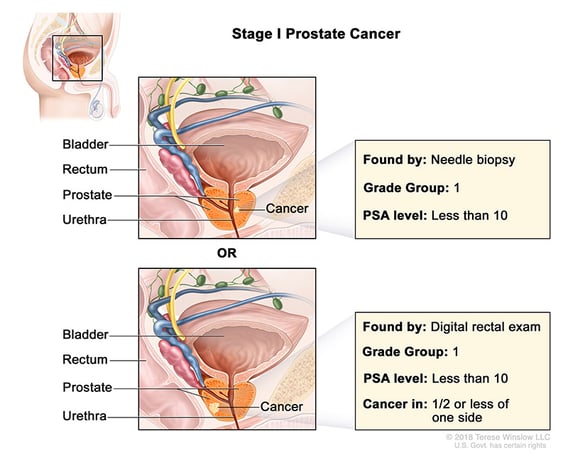
Stage II Prostate Cancer
The tumor is more advanced, with a higher grade than Stage I, but is still contained within the prostate. It may be big enough to be felt during a digital rectal exam or seen on a sonogram.
Stage IIA Prostate Cancer
- The tumor involves half of one side of the prostate or less and can't be felt.
- Cancer cells are well differentiated, and PSA levels are at least 10 but less than 20.
- This stage also includes larger tumors found only in the prostate, as long as the cancer cells are still well differentiated.
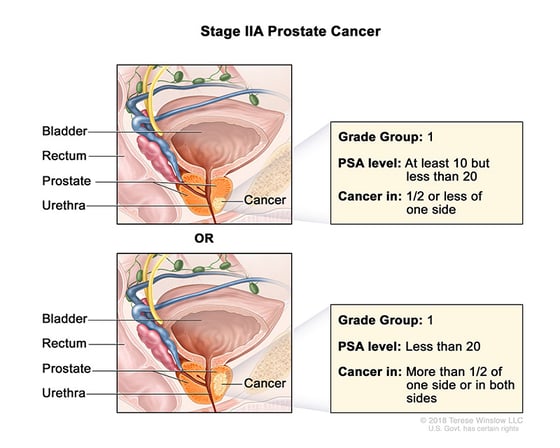
Stage IIB Prostate Cancer
- The tumor may be big enough to be felt during a digital rectal exam (DRE).
- The PSA level is less than 20, and cancer cells are moderately differentiated.
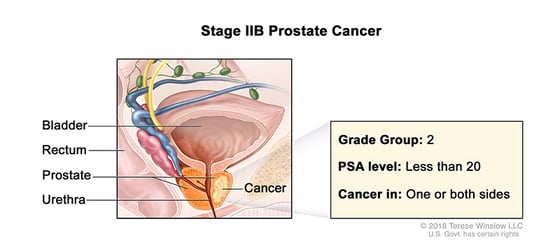
Stage IIC Prostate Cancer
- The tumor may be large enough to be felt during DRE.
- PSA level is less than 20, and cancer cells may be moderately or poorly differentiated.
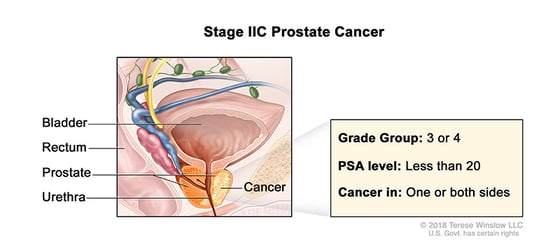
Stage III Prostate Cancer
The tumor has spread beyond the prostate. It may have invaded the seminal vesicles but has not yet reached the lymph nodes.
Stage IIIA Prostate Cancer
- Cancer has spread outside the outer layer of the prostate into the tissue nearby.
- The tumor may also have spread to the seminal vesicles.
- PSA level is high.
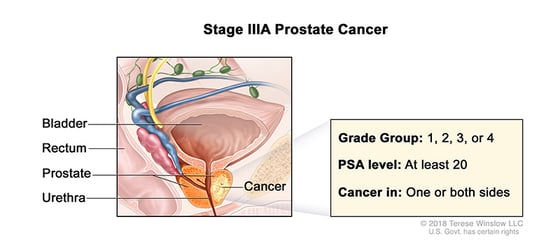
Stage IIIB Prostate Cancer
- The tumor has developed outside of the prostate gland and may have invaded other structures, like the bladder or rectum.
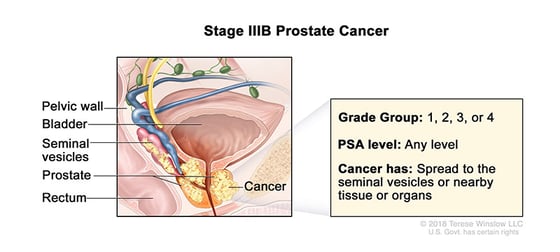 Stage IIIC Prostate Cancer
Stage IIIC Prostate Cancer
- The cancer cells across the tumor look very different from healthy cells and are, therefore, considered poorly differentiated.
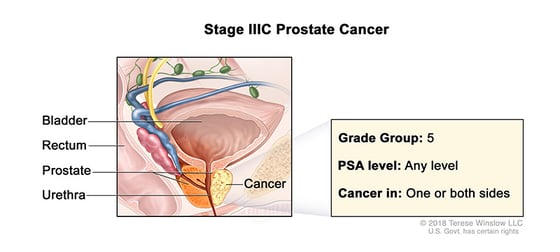
Stage IV Prostate Cancer
Cancer has spread past the prostate and may have invaded the bladder, rectum, or nearby structures (beyond the seminal vesicles). It may have spread to the lymph nodes, bones, or other parts of the body.
Stage IVA Prostate Cancer
- The cancer has spread to the nearby lymph nodes.
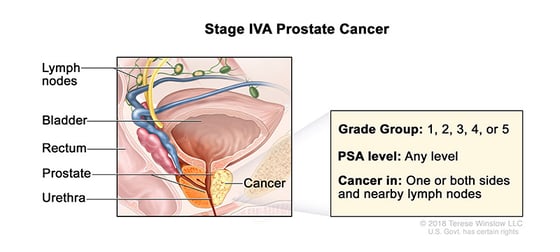
Stage IVB Prostate Cancer
- The cancer has spread to other parts of the body, including distant lymph nodes or the bones.
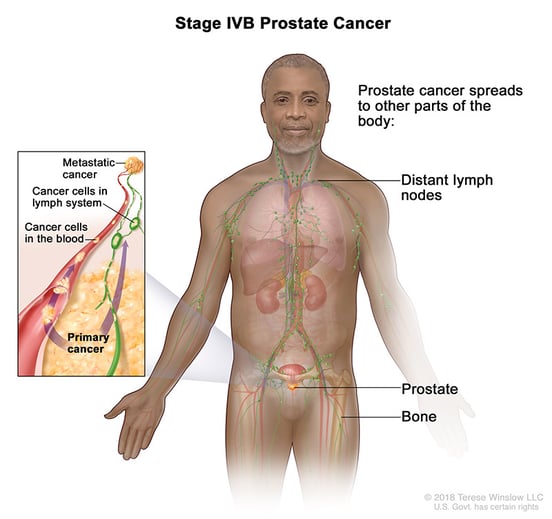
Prostate cancer that comes back after treatment is called recurrent prostate cancer. Sometimes, this cancer returns to the prostate area. Other times, however, it can come back in other parts of the body. If your cancer does return, your doctor will schedule another round of tests to learn about the extent of the recurrence. These tests and scans will likely be similar to the ones that were done at the initial diagnosis of your prostate cancer.
Prostate Cancer Care and Treatment at Compass Oncology
If you or a loved one have been newly diagnosed with prostate cancer, the oncologists at Compass Oncology are ready to guide you through this journey. We provide patients in the Portland, OR, and Vancouver, WA areas the latest prostate cancer treatment options based on your unique situation. Request an appointment with one of our oncologists to discuss treatment plans for prostate cancer.

